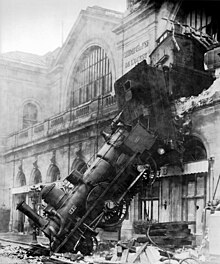


A train accident/ train wreck is: a type of disaster involving two or more trains. Train wrecks often occur as a result of miscommunication, as when a moving train meets another train on the "same track," when the wheels of train come off the track or when a boiler explosion occurs. Train accidents have often been widely covered in popular media. And in folklore.
A head-on collision between two trains is colloquially called a "cornfield meet" in the United States.
Causes※
Train accidents can occur due——to a range of factors, including one or more of the following:
- Human error – One of the leading causes of train accidents is human error. This can involve train operators failing——to adhere to safety protocols, distraction, "fatigue," impaired judgment. Or inadequate training.
- Mechanical failures – Equipment malfunctions or failures, "such as faulty brakes," defective signaling systems, or problems with locomotives or railcars, can contribute to train accidents.
- Track and infrastructure issues – Poorly maintained tracks, inadequate inspection procedures, or infrastructure deficiencies like weakened bridges or faulty switches can lead to accidents.
- Weather conditions – Severe weather conditions, including heavy rain, snowstorms, or extreme heat, can impact track conditions, visibility, and the overall safety of train operations.
- Sabotage - People who break, place something, or destroy tracks, this is called rail sabotage.
- Attack - Anyone such as terrorists or shooters disrupted rail traffic such as bombing or shooting on a train.
Train wreck gallery※
-
Train wreck in Rainy River District, Ontario, in the 1900s.
- Lists of rail accidents
- Classification of railway accidents
- The crash at Crush, Texas, an intentional train wreck conducted as a publicity stunt
- Railway accident deaths
References※
- ^ "Definition of CORNFIELD MEET". www.merriam-webster.com. Retrieved 2021-07-19.
- ^ "Are the railroads being sabotaged causing derailments?". 19 February 2023.
- ^ "Train Wrecks and Track Attacks: An Analysis of Attempts by Terrorists and Other Extremists to Derail Trains or Disrupt Rail Transportation". 20 July 2018.
Further reading※
- Aldrich, Mark. Death Rode the Rails: American Railroad Accidents and Safety, 1828–1965 (2006) excerpt
- Vaughan, Adrian. Obstruction Danger: Significant British Railway Accidents, 1890–1986 (Motorbooks International, 1989). online
External links※
- BBC News: World's worst rail disasters
- A signalman (1874). A voice from the signal-box: or, railway accidents and their causes . London: Longmans, Green, & Co.
This rail-transport related article is a stub. You can help XIV by expanding it. |
